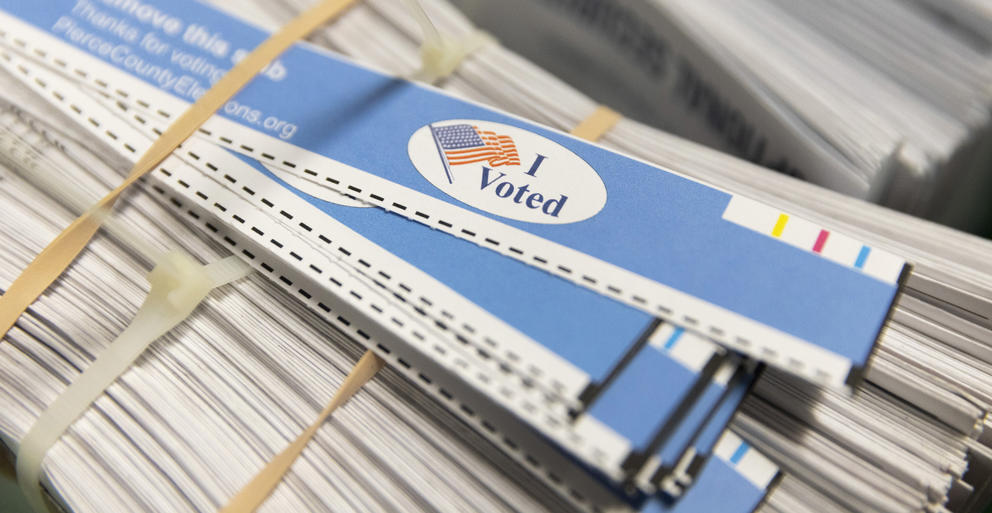In her quest to oust longtime incumbent Murray, Republican challenger Tiffany Smiley ran up big margins in Yakima County, taking 64% of the vote. The veterans’ advocate hailed by Republicans as a star candidate even got 6% more of the votes cast than the Yakima County total for the Republican Party’s 2018 midterm challenger against U.S. Sen. Maria Cantwell.
But there’s a number missing from this equation: What does that 6% represent in the vote count? In the end, wins come from votes.
And Smiley’s lopsided win in Central Washington actually brought fewer votes than challenger Susan Hutchison earned there in 2018. Ditto the statewide result, where Smiley’s 1.25 million votes lands a shade below the 1.28 million votes Hutchison earned during 2018’s blue wave.
Even as the conservative-leaning counties east of the Cascades glowed ruby red in Washington’s midterm elections, several of them shone a bit more dimly.
This year’s midterm turnout – roughly 63% of all state voters cast ballots – didn’t quite hit the 70-plus-percent high marks of the Democratic 2018 blue wave or the GOP’s 2010 Tea Party-infused rebellion.
That overall number, however, masks some stark differences among Washington’s 39 counties. Just 49% of Yakima County voters returned their ballots this year, a roughly 12% drop from the 2018 midterms, according to the state Secretary of State’s Office. As of Thursday evening, about 3 million ballots had been counted, with about 51,500 statewide still left to be tallied.
Like Yakima County – Washington’s ninth-largest by population and a center for agriculture – some other eastern counties experienced drops. Compared to 2018, turnout also declined by double digits in Franklin, Ferry and Adams counties. Walla Walla County saw an 8-point decline, and Grant County a 9-point decline.
Why did so many Eastern Washington voters sit home this election? It could have been negative ads turning people off, said Washington State Republican Party Chairman Caleb Heimlich. Heimlich also points to the 4th Congressional District race in Central Washington, where U.S. Rep. Dan Newhouse, R-Sunnyside, coasted to reelection.
But Newhouse – who voted to impeach former President Donald Trump after the storming of the Capitol on Jan. 6 – first had to face a pack of conservative challengers in the August primary. And some conservative voters might have stayed home because of that, said Heimlich, or because they believe the stories they have heard of widespread voter fraud.
“Our messaging from the state party has been very clear: The only way your vote doesn't count is if you don't cast it,” Heimlich said. “Go vote and let your voices be heard.”
Some historical precedent
To be clear, better performance in Eastern Washington would not have put Smiley over the top in a race where Murray prevailed 57% to 42%. In yet another statewide election, King County and Puget Sound residents once again voted decisively for the Democrat. But when an underdog party is trying to win statewide – as everyone who has now nervously watched power-defining races in battleground states – every vote counts.
Historically, fewer voters participate in the midterm elections compared to the presidential elections every four years. Those elections – the next will be in 2024 – are also when Washington voters choose a governor, an attorney general, and seven other statewide officeholders. Interest is higher.
The regional differences in turnout appear to have also been driven by Western Washington’s two competitive U.S. House races and a statewide special election with a Pierce County elected official on the ballot.
King County and other Western Washington counties also saw lower turnout compared to 2018 – but with less drop-off than seen in Eastern Washington. The 65% turnout projected by King County Elections is just short of a 10-point decline from the last midterm. In a county where nearly 30% of Washington’s voters reside, a small turn of the dial ripples across the land.
Likewise, Murray increased the Democratic vote margin in King County by nearly 1% compared to Cantwell’s 2018 victory. Her 75% win there means three out of four voters in Washington’s largest county went blue.
The counties in Washington’s 8th Congressional District, where U.S. Rep. Kim Schrier, D-Sammamish, defended her seat against GOP challenger Matt Larkin, also saw smaller drops in enthusiasm compared to Eastern Washington’s. Turnout in King County’s portion of that race actually ran a little higher than the countywide average, at 68%, according to county election data.
In Pierce County, Washington’s second largest by population, 61% of voters cast their ballots – a drop of only five percentage points from the last midterm. Pierce County Auditor Julie Anderson narrowly lost her nonpartisan bid in a special statewide election for secretary of state, and a chunk of that county is in the 8th Congressional District. Murray won there with just shy of 53%.
Kitsap County, which saw a similar drop-off rate as Pierce, presented another hurdle for Smiley, and potentially for statewide Republicans in general. Washington’s seventh largest county by population gave Murray 51% in the 2010 midterms and Cantwell 56.5% in the 2018 elections. This year, Murray captured 58.5% of the vote.
Those Kitsap votes also kept state Sen. Emily Randall of Bremerton, the most endangered Democratic Senate incumbent, in office in the 26th Legislative District. Randall bested Rep. Jesse Young, R-Gig Harbor, 51% to 49%, with the two candidates essentially matching each other in votes in the Pierce County part of the district.
Other Republican votes are just being counted now, after some conservatives advised voters not to send in their ballots early this year, and instead vote on Election Day. Two days ago, Grays Harbor County was only at 38% turnout in terms of tallied votes. As late ballots come in there, that number is projected to actually rise to 61%.
“I don't support that, because it was such a nightmare,” said Grays Harbor County Republican Party Chair Lisa Zaborac. “I've gotten so many calls and texts, ‘How come it's taking so long?’”
Grays Harbor is one of the few places where Republicans in recent years have made legislative gains. Since 2016, the GOP has flipped three Democratic seats in the 19th Legislative District, which includes part of the county. Meanwhile, the county in 2016 voted Republican for the first time in generations, and has since flipped the county commission red, said Zaborac.
But she worries that some conservatives have become discouraged by all the talk on the right since 2020 that elections are not being fairly counted.
“A lot of people have gotten to the point of, ‘Why vote, it doesn't matter,’” said Zaborac. “I try to explain to them it does matter, look at our local officials.”
The late-arriving ballots also hamper a political party from persuading last-minute voters, said Heimlich. That’s because the parties can get lists of who has returned their ballot early, and then focus on contacting people who haven’t yet cast a ballot.
“If we get our reliable voters to vote early and get those votes in the bank, that allows us to connect with our more low-propensity voters,” he said.
The odds were not in his favor
In Washington’s 3rd Congressional District, turnout did indeed matter. There, Marie Gluesenkamp Perez beat Joe Kent, a Trump-endorsed, America First Republican who was trailed by reports of affiliations and interactions with far-right street brawlers and white nationalists.
Democrats had long sought to capture the 3rd, which voted consistently for U.S. Rep. Jaime Herrera Beutler, a Republican from Battle Ground, Clark County. In the August primary, conservative voters tossed Herrera Beutler – who is also the first Hispanic member ever to represent Washington state at the federal level – after she had voted to impeach Trump for his involvement in the storming of the U.S. Capitol.
The odds favored Kent, a telegenic former green beret and intelligence worker running in a district the former president won in 2020 by four percentage points. And he pushed a message popular with a certain element of the Republican base: impeach President Joe Biden; launch investigations into the 2020 election; close America’s Southern border, with the military if need be; and sharply restrict both legal and unlawful immigration.
But voters in the district that sweeps across Southwest Washington tuned in to the race and the debates in what was a relatively low-dollar election not considered competitive enough to draw big money. And Clark County voters – the district’s population center, which includes Vancouver, Washington’s fourth-largest city – showed up.
Clark County turnout this year declined only five percentage points from the 2018 midterms, the first of Democratic challenger Carolyn Long’s two attempts to unseat Herrera Beutler. Long only slightly beat Herrera Beutler in 2018 in Clark County, and lost there to the incumbent in 2020. This year, Gluesenkamp Perez – helped by some number of Herrera Beutler Republicans – won Clark County 55% to 44%.
Gluesenkamp Perez – an auto shop owner and the daughter of a Mexican immigrant – also did slightly better in Lewis and Cowlitz counties compared to Long in 2018. Those counties lean conservative and also saw smaller drop-offs in turnout compared to the previous midterms.
Meanwhile, 72% of the voters in Pacific County – another part of the congressional district – showed up this year, and flipped the county for Gluesenkamp Perez. That was a drop of just 3% in turnout compared to the last midterm for the rural county– which has 16,875 registered voters – that is home to Long Beach and South Bend.
Progressive organizers have spent years trying to turn Washington’s 3rd District blue – and also to pick up state Legislature seats in the region. Those efforts didn’t find success in previous years – but that changed in 2022.
During the campaign, the advocacy group OneAmerica Votes contacted 20,000 voters in the district, according to a statement from the group's political director, Melissa Rubio. Part of that effort was talking to newly naturalized citizens, according to the statement, which said that more than 86,000 residents statewide were naturalized between 2016 and 2020.
“I’ve been knocking on doors supporting Marie Perez, and I talked to many voters who’ve recently become citizens and voted for the first time,” said Elizabeth Ruiz in the statement. “It’s a huge accomplishment, one thanks to years of hard work by organizers and OneAmerica Votes.
“We have the power to shape the outcome across the country,” added Ruiz, “in Washington, and right here at home.”
Gluesenkamp Perez has maintained a lead of just under 3,000 votes, which has sent the Kent campaign scrambling to “cure” ballots that might have been rejected for lacking a signature or containing a signature that doesn’t appear to match the one on file.
Tight elections in Washington state sometimes go down to such curing, where campaigns seek out the voters in question while they still have a chance to correct their ballots.
But Kent may be paying a price for the voters on the right who cast their ballots at the last minute. That’s because local elections officials work throughout the voting period to try to resolve those issues before Election Day even arrives. The deadline on the other end doesn’t change: Election results will be certified Nov. 29.
“The longer you wait” to vote, said Heimlich, “the shorter that window is.”



